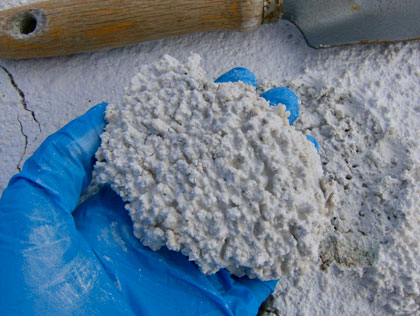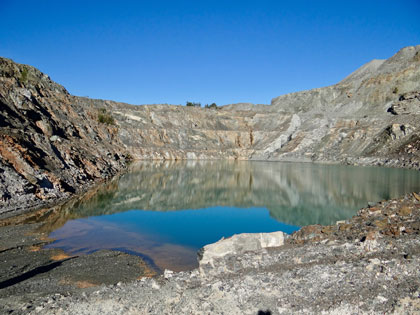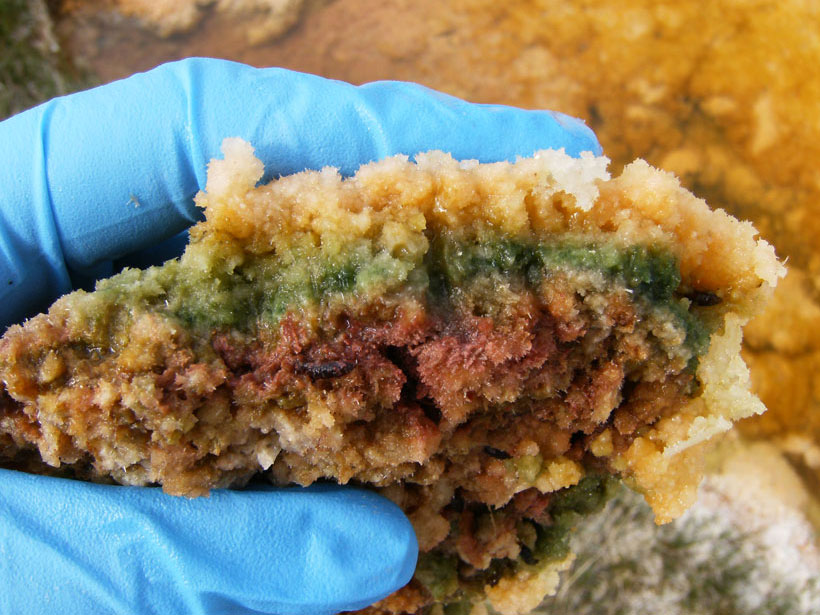Once celebrated for its heat resistance and durability, asbestos has now become synonymous with “hazardous” due to the health threats it poses when its tiny fibrils become airborne. As a result, the material has been phased out of most consumer products. But the legacy of asbestos mining in Canada and elsewhere around the world has left piles of hazardous material stranded at abandoned mines, with ongoing health threats to those living in close proximity.
Now researchers are looking for ways to clean up and repurpose that waste, all while trying to slow climate change. Jenine McCutcheon, a geomicrobiologist at the University of Leeds in the United Kingdom, has worked with colleagues to develop techniques that could turn abandoned asbestos tailings into deposits of magnesium carbonate, a group of minerals that includes the white powder that gymnasts and rock climbers use to improve their grip. Expanded on a large enough scale, this mine waste remediation could also help slow global warming by pulling carbon dioxide out of the atmosphere and storing it in stable carbonate rock form.
This carbon sequestration process occurs naturally as rocks break down over the course of millions of years. But McCutcheon and colleagues are devising a method to dramatically expedite that natural occurrence with the help of bacterial mats.
These methods could offer companies the opportunity to balance their budgets and do their part to slow climate change at the same time.
“We are looking to accelerate this process and transition it from a pile of asbestos waste to a deposit of carbonate mineral which is completely harmless,” says McCutcheon.
McCutcheon is the lead author of a recent study in Environmental Science and Technology documenting the methods that could prove useful not only at abandoned mines but also at active mines that are extracting rocks with similarly magnesium rich compositions, including copper, nickel, and platinum. Not only would the methods help clean up toxic waste; they also could offer a way for these mines to offset their carbon emissions—an asset that has become increasingly appealing as taxes on such emissions have emerged in places like Canada and elsewhere around the world.
“I think we are approaching the tipping point,” says McCutcheon, “of people having to more actively think about how the carbon tax will influence their finances.”
Once one of the world’s leading producers of asbestos, Canada is now a hot spot of abandoned asbestos mines. With the Canadian federal carbon tax of C$20/metric ton slated to increase to C$50/metric ton by 2022, these methods could offer companies the opportunity to balance their budgets and do their part to slow climate change at the same time.
A Dangerous Substance Turned Harmless
Asbestos includes a group of silicate minerals composed of tiny, fibrous crystals packed tightly together. The material doesn’t pose much of a hazard when fully intact, but as these crystals break down and become airborne, they can enter the body and cause major health problems, including lung cancer.
But the very quality that makes asbestos so hazardous to inhale also makes it especially well equipped to pull carbon dioxide out of the atmosphere, says McCutcheon. The thin fibrils have a very high surface area, which makes them highly reactive and readily able to transform into carbonates.
“This is a process we do see naturally occurring at mine sites,” McCutcheon says. “You can go to mine tailing storage facilities and climb these carbonate crusts.”

That’s in part because the mining process further increases the rock’s reactivity by pulverizing it into a fine powder, allowing a mineralization process that may take 1 million years in a solid boulder to occur within just 1 year at a mine site, says Sasha Wilson, a biogeochemist at the University of Alberta and previous adviser to McCutcheon during her Ph.D.
Those are “incredibly fast weathering rates,” Wilson adds.
Still, naturally occurring crusts tend to stop forming at a certain depth in tailings piles, so the carbon storage potential of these abandoned piles has been limited, Wilson notes. One problem researchers have found is that the crusts clog the pore space within piles, preventing fluids from seeping down to deeper depths.
“The reaction itself relies on carbon dioxide reacting with rainwater,” says Wilson.
If carbon dioxide–infused water can’t trickle down into the clogged pore space, the carbonation reaction will stop.
So Wilson, McCutcheon, and their colleagues devised a plan to see if cyanobacteria could help pick up the slack by providing a source of carbon in the system.
Cyanobacteria “are really good at concentrating carbon from the atmosphere,” says Wilson, because unlike most bacteria, they photosynthesize and absorb carbon dioxide during that process. “They collect it, they concentrate it, and when they die, they are decomposed by other bacteria, and that replenishes the supply of dissolved carbon in solution.”
Aside from tweaking the chemistry of the tailings in favor of carbonate mineralization, cyanobacteria can also provide a point of nucleation from which carbonate crystals can begin to grow, McCutcheon says. They also naturally tend to colonize many different types of environments, including mine sites, so inoculating tailings with cyanobacteria would not drastically change the surrounding environment.
“We would help their growth and increase cell populations to a scale that would be suitable for this carbon storage,” says McCutcheon.
The next task becomes devising a method to propagate these larger colonies of bacteria. “You really need to keep the bacteria happy,” says Wilson.
Scaling Up

To stay “happy,” cyanobacteria require the same three ingredients all photosynthesizing organisms need: water, sunlight, and nutrients.
McCutcheon notes that many abandoned mines have open pits that are already full of water, so those could provide good sources of wetlands for the bacteria. To help the bacteria grow, scientists would need to add nutrients (a solution of phosphorus and nitrogen). Leached mine waste could then pass through these bacterial mats, generating carbonate deposits.
As a proof of concept, McCutcheon’s team designed a lab-based experiment using a 10-meter-long series of tubes inoculated with cyanobacteria. They then introduced synthetic mine waste similar to what would be left behind at a mine site and fed the bacteria with a nutrient solution. Over the course of about 2 months, they found that the process did, indeed, produce substantial quantities of carbonate minerals.
Researchers estimate that scaled up, the reactions could store up to 238 metric tons of carbon dioxide per hectare of wetland per year. Scaled up to a square mile, that’s about 62,000 metric tons, or the equivalent of the annual emissions of about 13,500 cars.
These findings set the stage to implement these techniques at the mine scale, says McCutcheon. “We have all the tools in place,” she says.
As the carbon market has grown, other research groups have investigated the carbon storage potential of other types of mine tailings. But whereas some of those processes require the addition of heat, magnesium carbonates can form under relatively low temperatures, without the addition of an external heat source—and that’s a real asset for remote locations without the infrastructure to build high-temperature reactors, McCutcheon says.
Still, implementing the new process at abandoned sites may prove relatively complicated, notes Wilson, because many in Canada remain under the supervision of local governments and may not have associated funds to set up carbon storage facilities.
Companies are increasingly looking to revisit these abandoned sites, however, to remine them for other materials, such as jade. This technique could be a good option for those groups already planning to bring new infrastructure to these sites, says Wilson.
A Promising Future
Alissa Park, a chemical engineer at Columbia University who studies other methods of carbon capture and storage in mined materials, thinks these new methods could prove helpful as one promising form of carbon sequestration in the global carbon market.
“I think there is a good future for this technology,” she says.

McCutcheon notes that there could be unforeseen risks associated with the method, but these bacteria already naturally exist in these environments, so their impacts should be minimal. Groups would need to be mindful to inoculate sites with the species local to that particular mine to not throw off the natural balance, she says.
Louis-César Pasquier, a researcher at the Institut National de la Recherche Scientifique in Quebec City who studies mine waste recovery, agrees that these methods could prove promising if implemented at the mine scale.
Pasquier also notes that the new methodology would be even more appealing to companies if they were able to repurpose the carbonate minerals as value-added products. He sees potential for magnesium carbonates in products including pharmaceuticals and wastewater treatment, as well as building materials.
But the cost of production would need to be relatively low compared to the market value of those products. “You need to find the efficient and low-cost way to produce your by-products,” Pasquier says.
A Suite of Solutions
Despite these challenges, Pasquier thinks the new method could work in tandem with other carbon sequestration methods to move society forward in pulling greenhouse gases out of the atmosphere. “It will take all of the solutions to solve the large problem of greenhouse gas emissions,” he says.
It will take a suite of solutions to slow climate warming, and this is just one of many that could be implemented in those efforts.
Wilson agrees that it will take a suite of solutions to slow climate warming and that this is just one of many that could be implemented in those efforts.
“For a long time people were looking for a silver bullet,” Wilson says. But in recent years, industries have mobilized to create more diverse, smaller-scale carbon sequestration solutions. “I think there is going to be a lot of industry-by-industry problem solving when the crunch time comes.”
And with carbon taxes rising in Canada, that crunch time might be fast approaching.
“Necessity is the mother of invention,” Wilson says.
—Laura Poppick (@laurapoppick), Freelance Science Journalist
Citation:
Poppick, L. (2019), The carbon market potential of asbestos mine waste, Eos, 100, https://doi.org/10.1029/2019EO121453. Published on 06 May 2019.
Text © 2019. The authors. CC BY-NC-ND 3.0
Except where otherwise noted, images are subject to copyright. Any reuse without express permission from the copyright owner is prohibited.

